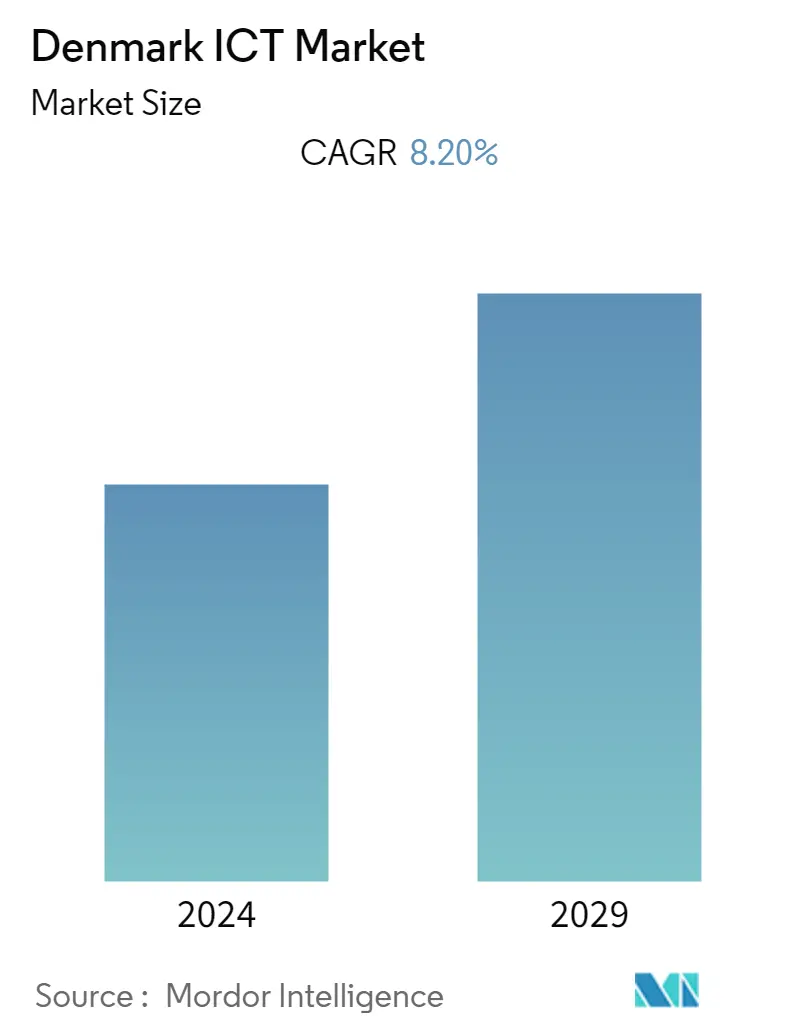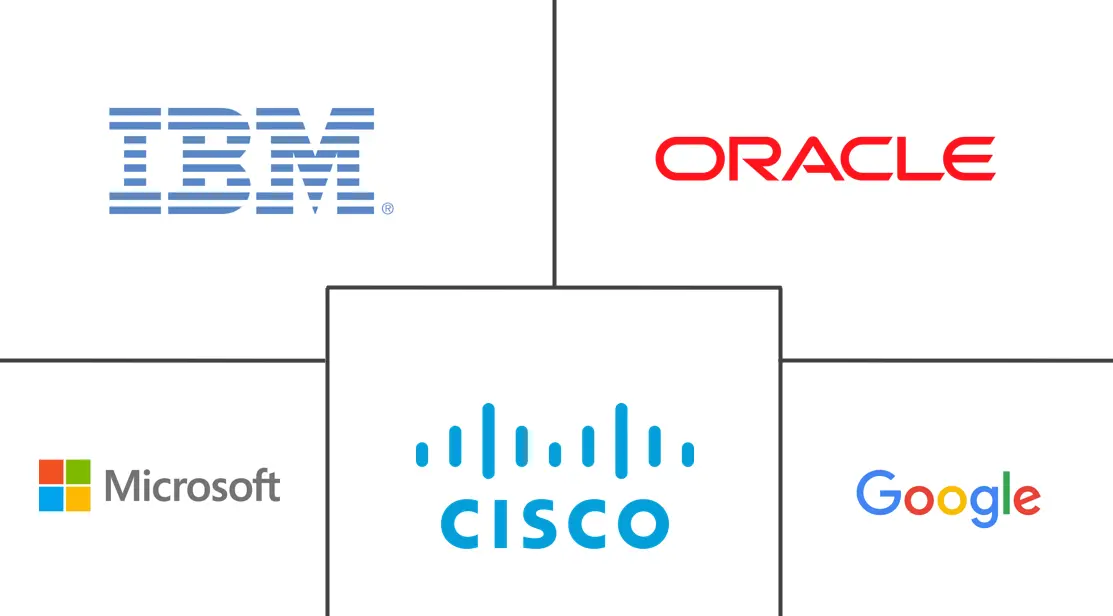Market Size of Denmark ICT Industry

| Study Period | 2019 - 2029 |
| Base Year For Estimation | 2023 |
| Forecast Data Period | 2024 - 2029 |
| Historical Data Period | 2019 - 2022 |
| CAGR | 8.20 % |
| Market Concentration | Medium |
Major Players
*Disclaimer: Major Players sorted in no particular order |
Denmark ICT Market Analysis
The Danish ICT market is expected to register a CAGR of 8.2% over the forecasted period. The Danish ICT landscape is changing at an unprecedented rate, owing mostly to the adoption and proliferation of novel apps and devices. Innovative technology developments such as mobility, cloud computing, analytics, and social media result in unique value chains and business models by establishing flexible organizations and improving the consumer experience. With more people using the Internet, broadband, and mobile phones, the ICT market can grow all over the country.
- Denmark's central, regional, and local governments have agreed on a new joint government digital strategy for 2022-2025. The strategy includes addressing labor shortages, mitigating climate change, and promoting digital inclusion. Denmark has one of the most digitized public sectors in the world. This is mainly due to the public sector's strong collaboration over the last two decades. Central, regional, and local governments have now approved the sixth Joint Government Digital Strategy.
- Recently, the Danish government signed the Berlin Declaration on Digital Society and Value-Based Digital Government, reaffirming its commitment, along with other EU Member States, to foster digital transformation so that citizens and businesses can take advantage of the benefits and opportunities provided by modern digital technologies. The Declaration aspires to contribute to a value-based digital transformation in European countries by addressing and promoting digital participation and inclusion. Such collaborations are expected to propel the market under consideration.
- To accelerate AI research in Denmark and gain more experience with the technology, specific goals have been established in four priority areas: health, energy and utilities, agriculture, and transportation. Furthermore, the country's AI strategy includes 24 programs across both the public and private sectors. DKK 60 million is set aside in the strategy for new ventures. Several public-sector hallmark AI projects, for example, are being carried out in collaboration with municipalities, regions, and private firms.
- During the COVID-19 epidemic, Denmark's public digital infrastructure proved its importance. With a significant degree of remote labor inside the state, regions, and municipalities, the digital infrastructure has enabled public service to stay at a high level. Furthermore, in response to COVID-19, the government launched a number of new digital services, including a contact-tracing app and digital booking of tests and vaccines. Furthermore, due to the pandemic, Danish individuals can now download their driving license from a mobile app and leave their physical driving license at home. People in Denmark have immediately adopted the new app, with over 500 000 downloads in the first 24 hours, about 750 000 in the first week, and now over 1 million.
- The increasing use of technologies such as cloud computing has led to the development of high-quality cloud-based applications. Cloud computing, which provides pay-as-you-go, low-cost computing resources, is rapidly gaining momentum as an alternative to traditional information technology (IT)-based organizations. As more users migrate their applications to cloud environments, service level agreements (SLAs) between customers and cloud providers become an essential factor to consider. Due to the dynamic nature of the cloud, quality of service (QoS) attributes must be constantly monitored to meet SLAs. As a result, cloud computing faces a QoS challenge. Specifically, how the service provider ensures her QoS is sufficient for cloud services.
Denmark ICT Industry Segmentation
Information and communications technology (ICT) is an extended term for information technology (IT) that encompasses a wide range of hardware, software, internet- and telecommunications-based services, social networking, media applications, and so on. The technology allows users to access, retrieve, store, send, and manipulate information in digital form. ICT technology has become more popular as the need for more advanced solutions like IoT, cloud computing, big data, content management, and so on has grown.
Denmark's ICT market is classified according to type (hardware, software, IT services, and telecommunication services), enterprise size (small and medium enterprises, large enterprises), and end-user vertical (BFSI, IT & Telecom, Government, Retail and E-Commerce, Manufacturing, Energy, and Utilities).
The market sizes and forecasts are provided in terms of value (USD million) for all the above segments.
| By Type | |
| Hardware | |
| Software | |
| IT Services | |
| Telecommunication Services |
| By Size of Enterprise | |
| Small and Medium Enterprises | |
| Large Enterprises |
| By Industry Vertical | |
| BFSI | |
| IT and Telecom | |
| Government | |
| Retail and E-commerce | |
| Manufacturing | |
| Energy and Utilities | |
| Other Industry Verticals |
Denmark ICT Market Size Summary
The Danish ICT market is experiencing rapid transformation driven by the adoption of advanced technologies such as mobility, cloud computing, analytics, and social media. These innovations are reshaping value chains and business models, fostering flexible organizations, and enhancing consumer experiences. The market's growth is further supported by increased internet, broadband, and mobile phone usage across the country. Denmark's government has implemented a comprehensive digital strategy for 2022-2025, focusing on addressing labor shortages, combating climate change, and promoting digital inclusion. The country's public sector is among the most digitized globally, benefiting from strong collaboration over the past two decades. Initiatives like the Berlin Declaration on Digital Society and the national AI strategy, which targets sectors such as health, energy, and transportation, underscore Denmark's commitment to leveraging digital transformation for societal and economic advancement.
The ICT market in Denmark is characterized by a competitive landscape with significant players driving innovation and development. The rise of cloud computing and digital payment infrastructures has been notable, with cloud-based applications gaining traction as cost-effective alternatives to traditional IT solutions. E-commerce, particularly in the fashion sector, is a significant contributor to the country's GDP, with technological advancements enhancing user experiences through augmented reality and programmatic advertising. The Danish government has set ambitious broadband goals, aiming for widespread high-speed internet access by 2025. Key industry developments include strategic partnerships and acquisitions, such as Microsoft's collaboration with Novo Nordisk and SOA People's expansion in the Nordic region. These efforts reflect a strong commitment to achieving rapid and effective digital transformation across both public and private sectors in Denmark.
Denmark ICT Market Size - Table of Contents
-
1. MARKET INSIGHTS
-
1.1 Market Overview
-
1.2 Industry Stakeholder Analysis
-
1.3 Industry Attractiveness-Porter's Five Forces Analysis
-
1.3.1 Bargaining Power of Suppliers
-
1.3.2 Bargaining Power of Consumers
-
1.3.3 Threat of New Entrants
-
1.3.4 Threat of Substitute Products
-
1.3.5 Intensity of Competitive Rivalry
-
-
1.4 Impact of COVID-19 on the Market
-
-
2. MARKET SEGMENTATION
-
2.1 By Type
-
2.1.1 Hardware
-
2.1.2 Software
-
2.1.3 IT Services
-
2.1.4 Telecommunication Services
-
-
2.2 By Size of Enterprise
-
2.2.1 Small and Medium Enterprises
-
2.2.2 Large Enterprises
-
-
2.3 By Industry Vertical
-
2.3.1 BFSI
-
2.3.2 IT and Telecom
-
2.3.3 Government
-
2.3.4 Retail and E-commerce
-
2.3.5 Manufacturing
-
2.3.6 Energy and Utilities
-
2.3.7 Other Industry Verticals
-
-
Denmark ICT Market Size FAQs
What is the current Denmark ICT Market size?
The Denmark ICT Market is projected to register a CAGR of 8.20% during the forecast period (2024-2029)
Who are the key players in Denmark ICT Market?
IBM Corporation, Oracle, Microsoft Corporation, Cisco Systems and Google LLC are the major companies operating in the Denmark ICT Market.

